Abstract
Hainan Island and its surrounding seabed are located at the intersection of the Eurasian, Indochina, and South China Sea tectonic plates with active Quaternary volcanism and intensive seismicity, such as the 7.6-magnitude earthquake that occurred in northern Hainan in 1605. Based on the newest airborne gravity data of Hainan Island and its adjacent areas, this paper uses wavelet multiscale decomposition followed by power spectral analysis to estimate the average depth of each layer of the source field. We use the Parker–Oldenburg method to invert the Moho structure, incorporating constraints from seismic data to investigate the fine crustal structure and deformation characteristics to elucidate the deep seismogenic mechanism. The regional Moho depth decreases from 30 km in the northwest to 16 km in the southeast. The map of the Moho surface shows three Moho uplift zones, located in the northern Hainan Island, the southern Qiongdongnan Basin, and the southwestern tip of Hainan Island. The following findings are revealed: Firstly, a series of northeastward high-gravity anomaly strips are discovered for the first time in the middle and lower crust of Hainan Island, which may be the remnants within the continental crust of the ancient Pacific northwestward subduction during the Mesozoic era. Secondly, under the Leiqiong volcanic rocks, there is a pronounced northeastward high-value anomaly and shallower Moho depth, which may indicate the deep-seated mantle material that rose and intruded during the activity of the Hainan mantle plume. Thirdly, the seismogenic structure is discussed by combining the wavelet multiscale decomposition results with natural seismic data. The results show that earthquakes occur in the place where the NE-trending gravity anomaly is cut by the NW-trending fault in the upper crust. That place also lies in the gravity anomaly gradient or high-value anomaly in the middle and lower crust. These features reveal that the earthquakes on Hainan Island are controlled by the left strike-slip activity of the Red River Fault and deep mantle upwelling caused by Hainan Plume.
1. Introduction
Hainan Island and the adjacent sea areas lie within a region where three plates meet: the Eurasian plate to the north, the Indosinian plate to the west, and the South China Sea Ocean Crust to the southeast [1,2,3]. Since the Mesozoic–Cenozoic era, a series of tectonic events have taken place in the northwestern South China Sea, such as the NW-trending subduction of the paleo-Pacific plate [4,5,6] and the mantle convection of the Hainan Plume, which leads to the Leiqiong volcanic area [7,8,9,10,11]. The Cenozoic extension of the South China Sea caused a large-scale extension around Hainan Island [12,13,14]. This unique tectonic setting has led to the complex geological environment of Hainan Island, and it has relatively intense volcanic activity and seismicity, such as the 1605 M7.6 Qionghai earthquake [15]. The significant volcanic rock and seismic activity are obvious responses to the deep structure and tectonic transition in the interior of Hainan Island. Research on the crustal structure of this area is important for understanding the continental accretion and the Genesis of the seismic activity.
The deep structure of Hainan Island has attracted substantial attention, and many researchers have investigated the crustal structure under the Hainan region mainly based on receiver functions, seismic tomography, and wide-angle seismic exploration [16,17,18,19,20,21,22,23]. The main conclusions of geophysical studies are as follows: the crustal thickness thins from the mainland of the South China Block to Hainan Island, and several studies suggest that the Moho depth of Hainan Island and the surrounding seabed is 25–30 km [24]. The upper crust has been through intense stretching, and three basins have formed around Hainan Island, with thicker sediment from north to south. Beneath the Qiongzhou Strait, the Pn anisotropic velocity model reveals a low-V anomaly, which is inferred to be the upwelling mantle under the lower crust [11]. However, there are ongoing debates about the Moho depth in the study area. Shawn Wei [16] found that the crust is 40–45 km thick around the northeastern side of the Qiongzhou Strait.
The geophysical research on the crustal structure in this area mainly focuses on the crust–mantle scale, and most of these studies are based on several limited seismic observation stations, only covering the onshore section of the research area. The crustal structure is an important area of research in terms of the seismogenic mechanism and tectonic deformation between the South China Craton and South China Sea. Recently, a joint airborne gravity survey was conducted by the Chinese Geologic Survey in the area (Figure 1). The airborne gravity data improve the resolution of medium–long-wavelength gravity anomalies and provide more information about the deep crust. Based on these airborne gravity data and satellite gravity data, this paper aims to elucidate the structure and deep deformation of Hainan Island and its surrounding seabed using the gravity anomaly separation inversion method and provide a multi-dimensional density structure under the constraint of seismic research results and geological information. Then, we explain the tectonic significance of the crustal structure and its relationship with seismogenic mechanisms. Our result also provides new insights into the crustal structure of the northwestern SCS.
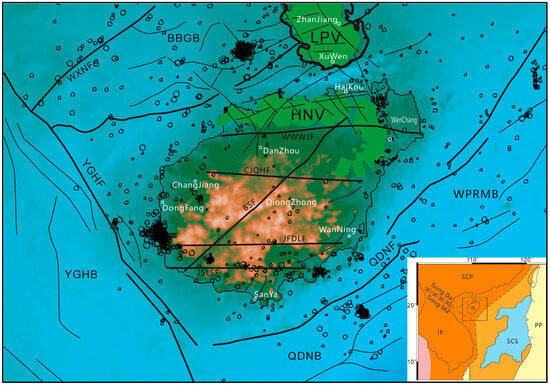
Figure 1.
The geological location of the study area and the topography of Hainan Island. The solid line represents faults modified from [25,26]. The circle represents the location of the epicenter of the natural earthquake, and the bigger circle represents the magnitude. The green patches indicate the distribution of the Leiqiong and Hainan volcanic rocks. YGHF, YingGeHai Fault; WXNF, WeiXiNan Fault; YGHB, YingGeHai Basin; QDNF, QiongDongNan Fault; WWWJF, WangWu–WenJiao Fault; BSF, BaiSha Fault; JFDLF, JianFeng–DiaoLuo Fault; CJQHF, ChangJiang–QiongHai Fault; JSLSF, JiuSuo–LingShui Fault; BSF, BaiSha Fault; QDNB, QiongDongNan Basin; BBGB, BeiBu Gulf Basin; WPRMB, West part of Pearl River Mouth Basin; SCP, South China Plate; SCS, South China Sea; PP, Philippine Plate; IP, Indosinian plate; HI, Hainan Island.
2. Geological Setting
Hainan Island is located in the southwest of South China, which lies at the conjunction of the Eurasian, Indian–Australian, and Pacific plates [2,27,28]. The geodynamic process and geological evolution history is complicated, and there are three typical geological provinces in Hainan Island. The first are amphibolitic gneisses, granulites, and charnockites, making up the Paleoproterozoic basement, and they are represented by the Shilu Group and Baoban Group [29,30]. The second is the granitoid of the Permo-Triassic and Jurassic–Cretaceous ages intruded into the basement, which is thought to record continental accretion events [2,27,28,31,32]. The formation of Jurassic–Cretaceous granitoids is associated with the subduction of the paleo-Pacific plate beneath Eurasian plates [31,32]. Overlying the other two are Leiqiong volcanics in the northern part of island. Those volcanoes were composed of basaltic lava [33,34] that came from the deep mantle related to the activity of the Hainan Plume.
The tectonic division of Hainan Island has been widely discussed by many experts. Three trending faults exist in our study area, which are NE-trending faults, such as the Baisha, Weixinan, Gezhen, and Qiongdongnan faults; EW-trending faults, such as the Wangwu–Wenjiao, Changjiang–Qionghai, and Jiusuo–Lingshui faults; and NW-trending faults, the Red River Fault, such as the Changliu–Xiangou and Puqian–Qinglan faults. The EW-trending faults are considered to have formed first. The NE-SW trending faults are the dominated tectonic faults in Hainan Island, whose formation is inferred to be related to the NW-trending subduction of the paleo-Pacific plate beneath the Eurasian plate. The NW-trending faults are a group of seismogenic faults, whose formation is related with the strike-slip of the Yinggehai Fault in Cenozoic influenced by the remote squeezing-out effect of the Tibetan Plateau collision. Surrounding Hainan Island are three important Cenozoic sedimentary basins, including the Qiongdongnan Basin, Beibuwan Basin, and Yinggehai Basin [26,35,36,37].
Located at the margin of three plates and influenced by the plume from deep mantle [9,10], Hainan Island is also a seismically active region. According to the seismic data from the China Earthquake Administration, about 820 earthquakes have occurred since 2001. Analysis of those data shows that 7% of earthquakes in our study area are larger than magnitude 3, and the depth of the earthquake’s center is between 1 km and 30 km. The famous 1605 Qiongshan Earthquake occurred in the north of Hainan Island. Xia et al. [38] divided these earthquakes into four distinct earthquake swarms and inferred that seismic activity in Hainan Island is affected by the deep crust–mantle magmatic fluid movement.
3. Materials and Methods
3.1. Data Source
The airborne gravity survey was conducted by the China Aero Geophysical Survey & Remote Sensing Center for Natural Resources from 2016 to 2019 using an integrated airborne gravity survey. The Cessna 208 B survey aircraft (rented from China Aviation Industry General Aircraft Co., Ltd., Zhuhai, China) was equipped with a GT-2A gravimeter (JSC STC Gravimetric Technologies, Moscow, Russia) and DGPS location system (ProFlex800 GPS, Ashtech Company, Sunnyvale, CA, USA). The main survey grid over Hainan Island was flown with 2 km survey line spacing and tie lines every 10 km. The airborne gravity data were obtained at an average GPS altitude of 600 m, with better resolution to reveal the crustal structure. The internal accuracy of the mean square deviation of the airborne gravimetric measurement for a repeated line test is around 0.6 mGal [39,40]. The airborne free-air gravity anomaly was calculated after field data preprocessing and basic correction, such as instrument drift and the effect of the EotvÖs’s indoor processing; then, the Bouguer gravity data were obtained by removing the terrain effects of the seabed and topography using the Terrain Correction modules of the Oasis Montaj software (8.4.1 version) platform produced by Geosoft Inc. of Toronto, ON, Canada, using 1030 kg/m3 for seawater and 2670 kg/m3 for rock.
3.2. Methodology
3.2.1. Multiscale Wavelet Analysis
The regional Bouguer gravity contains the density information of the earth. To reveal the crustal structure, we decompose the gravity field data according to the depth of the field source and obtain the gravity anomaly subset of the equivalent layer at a different depth. The multiscale wavelet analysis method was first established in 1985, and it has become more popular in separating the field data. Yang et al. [41] has designed the wavelet base for the multiscale decomposition of the gravity anomaly wavelet and applied this method to geological tectonic research.
The basis of the multiscale wavelet analysis for regional gravity data processing is that the horizontal scale of gravity anomalies is proportional to the buried depth of the gravity sources [42,43,44]. The multiscale wavelet analysis can be expressed as in Equation (1):
where Δg(x,y) is the Bouguer gravity anomaly with coordinates (x,y) on the geoid, Aif(x,y) is the wavelet base corresponding to the large-scale regional density structure, Di(x,y) is the decomposed Bouguer gravity anomaly that represents the equivalent layer at different depths, and i is the decomposed maximum order.
In this paper, we use the multiscale wavelet analysis method to decompose the Bouguer gravity anomaly in the study region. The D1–D7 detailed gravity anomaly and 7th-order wavelet approximation were obtained. (D1+D2+D3) is regarded as the gravity anomaly caused by a shallower crust. In the study region, this layer is related to the uppermost crust. Different wavelet details reflect gravity anomaly sources at various depths.
3.2.2. Radial Averaged Logarithmic Power Spectra
After decomposing the Bouguer gravity anomaly, we used the radial averaged logarithmic power spectrum method to calculate the depth of every equivalent geological layer [45,46,47]. The radial average logarithmic power spectrum was calculated, and linear fitting was performed. The slope of the line is regarded as the corresponding equivalent source layer depth. The depth result is shown in Table 1.

Table 1.
Depth of each decomposed gravity anomaly source layer.
3.2.3. Parker–Oldenburg Method
Parker and Oldenburg [48,49] improved this method to calculate the geological layer depth from field data. The Parker–Oldenburg inversion method is based on the potential field iterative inversion formula of a single interface in Equations (2) and (3). During calculation, we adjust the setting of ekz0, denoting the high-frequency amplification factor, and the convergence condition of the iteration to be suitable for the geological tectonic structure. The observing plane depth Z0 is 600 m, which is the same as with our flight height, and the density difference is 0.3 g/cm3, which we collected from the articles in [9,11].
4. Results
4.1. Bouguer Gravity Anomaly Analysis
From the continental area to the sea, the Bouguer gravity anomaly in the study region changes from negative to positive. The Bouguer gravity anomaly reflects large-scale tectonic information and sedimentary basin features. In the Yinggehai Basin, the value ranges from −50 to 0 mGal with the NW-trending negative anomaly. The Yinggehai Basin is separated from the South China Block by the Red River Fault. The Red River Fault is apparently a gravity gradient belt, and the gradient can reach 2.4 mGal/km, indicating that it reflects the boundary of different blocks. The Central Hainan Island Low Anomaly Zone is characterized by a central negative anomaly surrounded by positive anomalies, which clearly separates Central Hainan Island from other units. The large negative Bouguer gravity anomaly of Central Hainan Island reflects the large-scale intrusion of granite in Hainan Island and the subsequent stronger uplift of this terrain. Local anomalies show the superimposed northeast and northwest directions. There is a striking high-value anomaly zone in the north of Hainan Island, with high anomalies and low anomalies arranged regularly, reflecting the extensive distribution of Leiqiong basaltic rocks on the surface. The overall Bouguer gravity anomaly of BBWB is negative, and the basin boundary is reflected well from the gravity anomaly. The northern part of the gravity anomaly background is lower than the southern part, which is consistent with the feature that where the northern part is a sag, the southern part is an overthrust. The Qiongdongnan Basin is situated on the southeast side of Hainan Island. The gravity anomaly value is significantly higher than the other area, increasing gradually from land to sea. It is separated from Hainan Island by a clear anomaly gradient band, indicating the Qiongdongnan Fault. Northeast Hainan Island, formerly known as the Hainan Uplift [50], exhibits alternating positive and negative gravity anomalies. This area is the southern extension of the South China Block.
4.2. Decomposed Gravity Anomalies
Using the multiscale wavelet analysis method, we can separate shallow small-scale source bodies from deep and large-scale source bodies [51]. Based on Equation (1), we performed an eighth-order wavelet decomposition on the gravity data in the study area, and the decomposition results are shown below (Figure 2, Figure 3, Figure 4, Figure 5 and Figure 6). We also collected modern earthquake data from the National Earthquake Data Center website and plotted the earthquake epicenter in each decomposed result.
By calculating the power spectrum, we estimated the depth of each decomposed gravity anomaly wavelet, as shown in Table 1. The calculated depth of the shallow layer D3 is 3 km, and D4 is 5 km. The middle layer, D5, is 11 km, and D6 is 19 km. The deep layer, D7, is 27 km. The shallow layers are located on the upper crust. The middle is located in the middle crust, while the deep layer is located in the lower crust, and the upper mantle is related to the shape of Moho.
The gravity anomaly of the D1–D3 wavelet detailed field mainly reflects the top of the upper crust, as shown in Figure 2. The map shows the density disturbance of sedimentary rocks and the small-scale density anomaly with an average depth of 3 km. The negative anomaly relates to the Cenozoic sedimentary depression belt, such as the BBGB, YGHB, and QDNB. In BBW and northern Hainan Island, small-scale NW-trending liner gravity anomalies exist. As can be seen from Figure 2, these NW-trending anomalies terminate to the Wangwu–Wenjiao fault. The NW-trending fault is mainly affected by the large-scale left-lateral displacement of the YGHF during Neogene.
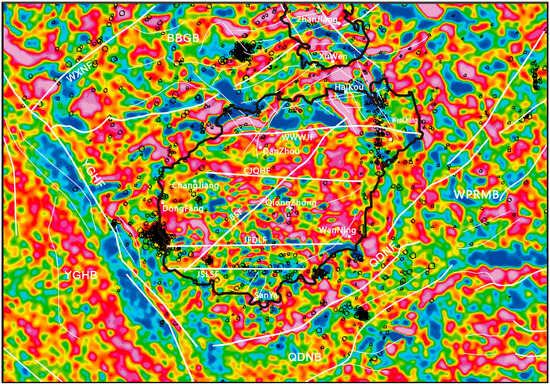
Figure 2.
D1–D3 decomposition results of gravity anomaly; the blue represents the low gravity anomaly value, and the red represent the high gravity anomaly value.
The decomposition results of D4 and D5 mainly correspond to depths of 5 km and 11 km, respectively. The maximum and minimum values of D5 are −20 mgal and 45 mgal. With the depth increasing, the decomposition results show that the density inhomogeneity in the upper crust decreases. D4 and D5 represent the density anomaly of the middle crust. As can be seen from Figure 3, D4 shows that the main fault in the study area corresponds with the gravity gradient belt. The YGHF is located on the southwest of Hainan Island with a positive–negative–positive gravity gradient belt. The YGHB shows a chaotic NW-trending negative gravity anomaly. The “Two depressions and one uplift” structure of the BBGB is well expressed too. The Qixi uplift zone of the BBGB is expressed as a nearly NE-trending positive anomaly belt. And the QDNF is an NE-trending gravity gradient belt on the southeast of Hainan Island. The gravity anomaly of the QDNB is nearly NE-trending. Figure 4 clearly delineates the depressions and uplifts of the QDNB. Central Hainan Island displays distinct gravity anomalies with NE-trending and WE-trending belts. This geophysical contrast suggests that Central Hainan Island constitutes a unique tectonic unit distinct from surrounding marine terrains.
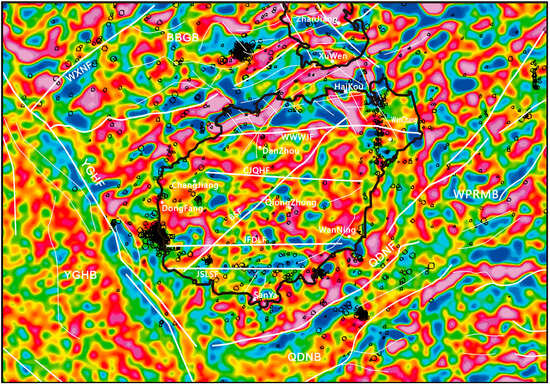
Figure 3.
D4 decomposition results of gravity anomaly.
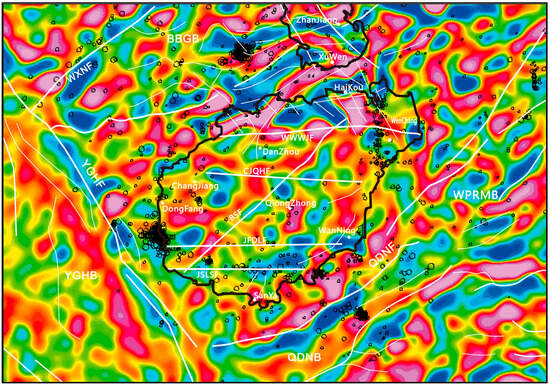
Figure 4.
D5 decomposition results of gravity anomaly.
The D6 and D7 wavelet details are smoother with an increasing source depth. According to previous research results in the study area, the mean Moho depth is about 28 km. The D7 wavelet detail with an average source depth of 27 km is interpreted as the gravity anomaly caused by the Moho discontinuity. From D6 (Figure 5), there are a series of NE-trending positive–negative–positive gravity anomaly stripes in the central part of Hainan Island. This gravity anomaly combination represents the density anomaly in the middle and lower crust, induced by tectonic deformation. According to the stress direction, it may be affected by the ancient Pacific NW subduction and form a series of NE-trending tectonic patterns [52,53]. The Qiongzhou Strait fault zone exhibits a NE-trending high gravity anomaly belt in D4–D6 (Figure 3, Figure 4 and Figure 5). The gravity anomaly of this fault gradually increases continuously from D4 to D6, indicating that the fault has cut through the deep crust. The QDNF is manifested as a set of positive–negative–positive gravity gradient zones. There exists a near-northwest-oriented high gravity anomaly in the YGHB, which has spatial consistency with the basalt intrusion shown in the research article [23].
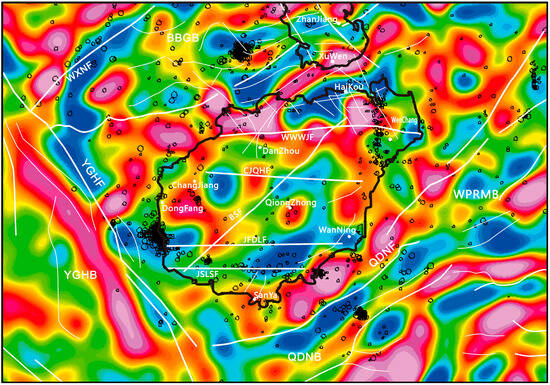
Figure 5.
D6 decomposition results of gravity anomaly.
4.3. Moho Topography
This study collects the Moho depth from published studies [17,18] as constraints in the Moho inversion. Utilizing deep-reflection seismic velocity profiles within the study area, we calculated the density difference between the upper mantle and lower crust. The lower crustal density is defined as 2.84 g/cm3, whereas the upper mantle density is defined as 3.28 g/cm3. The density difference is approximately 0.36 g/cm3. Previous seismic investigations delineate an average Moho depth ranging from 25 to 30 km. The D7 decomposition results (Figure 6) corresponds to a field source depth of 27 km (Table 1), which is selected as the anomaly data for the Moho inversion. Using the Parker–Oldenburg inversion method, the Moho depth map is shown in Figure 7.
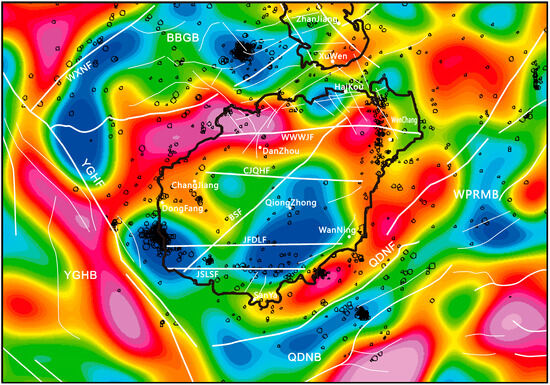
Figure 6.
D7 decomposition results of gravity anomaly.
The Moho inversion results (Figure 7) reveal that the average depth of the Moho in the study area is approximately 25 km. The Moho varies significantly with a change range of 16.2 to 31.4 km. The Moho depth becomes shallower from the northwest part to the southeast part in the study area, indicating that the crust thins from northwest to southeast. Two Moho depression zones within Hainan Island are apparently reflected. The first is located along the line of Wuzhi Mountain–QiongZhong–BaoTing. This Moho depression is distributed in an elliptical shape with an NE-trending axis, showing a negative correlation with the terrain. The other Moho depression zone is located in the eastern coastal zone and does not show a negative correlation with the terrain. Three distinct Moho uplift anomalies are delineated to be surrounding Hainan Island:
- (1)
- The first uplift is along the line of Lingshui–Wanning–Qizhou Island in the southeast of Hainan Island. The depth of the first Moho uplift decreases significantly from approximately 28 km to 23 km in the southeast part.
- (2)
- The second Moho uplift region is located 30 km off the west coast of Hainan Island beneath the YGHB, with the shallowest Moho depth ranging from 23 km to 25 km.
- (3)
- Located on the north part of Hainan Island, the third Moho local uplift zone is EW-trending with slow depth variation. The shallow part of this Moho uplift corresponds to the Hainan volcanic rock area.
These three uplift zones form roughly discontinuous circular rings, and Hainan Island is separated from the surrounding plates.
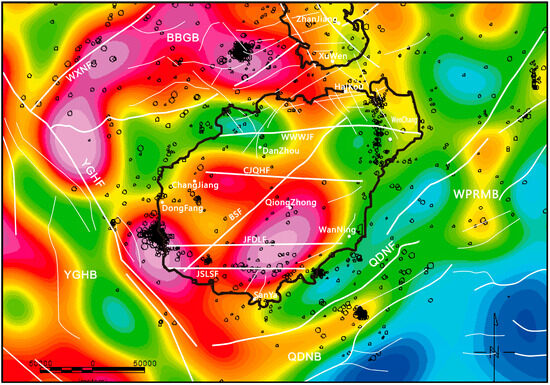
Figure 7.
Inverted Moho surface topography from D7 decomposition results.
The Moho topography beneath the YGHB, BBGB, and QDNB is different, indicating that the three basins might have different origins. From the Qiongzhou Strait northwestward, the Moho discontinuity depth deepens markedly to 26–31 km. In the BBGB, the shape of the basin basement geometry inversely correlates with Moho topography, indicating that the basin originated in tectonic extension. In the southwest, the average Moho depth in the YGHB is 26 km, ranging from 24 km to 29 km. The YGHF cut through the Moho interface. The Moho depths gradually deepen southwestward in the YGHB, accompanied by pronounced local Moho uplifts. In the southeastern part of the study area, the Moho discontinuity in the QDNB is the shallowest, and the Moho depth ranges from 18 km to 23 km.
5. Discussion
5.1. Gravity Moho Compared with Previous Studies
The depth of the Moho interface is an important parameter of the Earth’s structure, and many experts have focused on its variations. To evaluate the Moho interface results, we compared the inversion result in this study with the published results. The result is shown in Table 2. Jia et al. [18] demonstrated that the Moho depth reached 25 km from the Baiyan in Leizhou Peninsula to Jianghong in northern Hainan Island with minor spatial fluctuations. The results derived from natural seismic stations in Hainan Island [17] indicate that the Moho depth was deeper in the southern part of Hainan Island, averaging 30 km, and shallower in the northern part, ranging from 26 to 29 km. Wei Shawn [16] acquired four deep reflection seismic profiles across Leizhou Peninsula and the northern part of Hainan Island. Their results reveal a localized thickening of Moho [16] within the QiongZhong Strait, with measured depths of 35 km and 45km. Only two deep reflection seismic profiles exist in the offshore research area. The Moho depth results of the ESP-W profile vary from 31 km to 12 km, with large fluctuations. Our results are consistent with the measurement results obtained by Huang et al. [17] and others’ results. Overall, the thickness of the continental crust thins from 30 km to 28 km along the coastal zone. The calculation results in the QDNB are consistent with mechanics analysis [54]. However, our result outlines the contours of the Hainan Uplift more clearly.

Table 2.
Statistics of the differences between the new Moho depth model and corresponding models from the literature.
The discrepancies between the gravity-derived Moho and seismic-constrained Moho arise from the following factors: The Moho discontinuity obtained by gravity inversion may be smoother and more gradual than that obtained by seismic measurements. On the planar surface, gravity data points are denser, and the gravity grid is filtered through a 5 × 5 km window using the Parker inversion method. Secondly, in the basin, there may be density differences caused by a density parameter that is higher or lower than the basin sediment, which could affect the Bouguer gravity anomaly calculation. Thirdly, intense magmatic activity caused by the Hainan Plume exists. Magma from the deep mantle upwells and crystallizes in the lower crust, leading to an increase in the density of the crust. The deviation of the lower crust density would also affect the Moho inversion result. Finally, gravity-derived Moho primarily reflects its structural trend, since it is calculated using Moho density contrasts. In contrast, seismic Moho measurements typically provide the absolute value.
The Moho uplift in the northern part of the island (Figure 7) is clearly delimited by the WWWJF on the surface. This uplift is consistent with the P-wave velocity structure inversion results, which correspond to low-velocity anomalies [11]. The Hainan Island volcanic rock area is also exposed within this uplift. All these facts support the conclusion that beneath this Moho uplift, there may be a magmatic activity hotspot caused by the Hainan Plume.
5.2. Geological Implication of High Gravity Anomaly in Central Hainan Island
Our gravity anomaly decomposition results reveal a series of NE-trending linear anomalies in the middle-to-lower crust of the study area. The gravity Moho inversion results also highlight several interesting features. We contend that these anomalous belts have recorded the evolutionary history of Hainan Island. Located at the intersection of three continental plates (Figure 1), Hainan Island has a complex tectonic history, and three fault systems in the EW, NE, and NW directions remain. The influence of the Tethyan tectonic system and the Paleo-Pacific tectonic system on Hainan Island since the Phanerozoic era is still an important issue in the region’s tectonic evolution. Currently, research is mainly conducted using petrology and geochemistry methods. The results still allow for multiple interpretations, though many issues remain unresolved.
Our analysis clearly identifies NE-trending fault structures in D5 (Figure 4) and D6 (Figure 5), demonstrating two key implications: these fault structures are more developed in the middle crust, and the NW-trending subduction of the paleo-Pacific plate predominantly shaped the deep geological structures of Hainan Island. Previous studies have extensively investigated the granites of Hainan Island. There are currently two theories: One view is that the granite of Hainan Island from the Paleozoic era to the Mesozoic era is the post-collisional products linked to the northwestward subduction of the paleo-Pacific plate. They thought that the granites on Hainan Island share formation characteristics with those in the Pearl River Mouth Basin, collectively forming an arc-shaped granite belt [32,53]. An alternative view proposes that these granites originated in the Tethyan tectonic system and exhibit genetic similarities to those exposed in the Indochina Peninsula. Proponents of the latter argue that the granite on Hainan Island represents products of the eastward extension of the Tethys Ocean [6,18,55,56]. Our results predominantly support the first interpretation: Hainan Island became incorporated into the Paleo-Pacific subduction system during the late Paleozoic era, and numerous NE-trending faults developed throughout this subduction phase.
5.3. Crustal Structure Features and Seismic Activity
Located on the southern margin of the South China Block, Hainan Island is situated within a stress environment influenced by the collisional extrusion of the Tibetan Plateau and the westward subduction of the Philippine Sea Plate. The decomposed Bouguer gravity anomaly map and Moho depth map (Figure 7) reflect the crustal mass distribution. To further investigate the relationship between the crustal density anomaly and seismic activities in the study area, we collected natural seismic data from 2000 from the official website of the Hainan Earthquake Bureau. The distribution of focal depths relative to the Moho surface indicates that deeper earthquakes predominantly occur along Moho gradient zones. Figure 7 characterizes these zones by significant vertical shear stress and strong vertical differential motion. Decomposed gravity anomalies D4 (Figure 3) in the BBGB and northern Hainan Island exhibit NW-trending dislocation trace earthquake epicenters mainly concentrated along the NE boundary faults in the basin. On the D5 and D6 decomposed results, NE-trending faults appear as gravity anomaly gradients, indicating that seismic activity in the BBGB occurs due to the interaction of NE-trending and NW-trending faults. In the QDNB, Lin et al. [23] have demonstrated deep material upwelling beneath the Qiongdongnan earthquake cluster. Our study also reveals high-density anomalies consistent with Lin et al.’s findings, indicating that the earthquake cluster is mainly driven by deep material activities.
The high gravity anomaly observed in the northern part of Hainan Island is likely attributable to the upwelling of deep material driven by the Hainan mantle plume. The high gravity anomaly is related to seismic activity in northern Hainan Island, as shown in Figure 8. D5 (Figure 4) and D6 (Figure 5) reveal a prominent nearly NNE-trending high gravity anomaly zone beneath the volcanic earthquake cluster in the northern part of Hainan Island. This feature indicates the presence of a high-density body that protrudes relative to its surroundings, evidenced by both the D5 and D6 wavelet decomposition results. To interpret the results, we built a conceptual model in Figure 8. The Moho interface also exhibits pronounced uplift in this region, suggesting the potential upward intrusion of mantle material into the lower crust. Extensive Quaternary volcanic rocks are observed in the shallow subsurface [57,58], indicating an intense mantle–crust interaction in this region. The deep structure of northern Hainan Island is prone to stress accumulation, leading to significant historical events such as the 1605 Qiongshan earthquake and frequent contemporary seismic activity in this region. The existence of the Hainan mantle plume has been confirmed by various geophysical studies [9,10,17,58], and its active location is situated between northern Hainan Island and the Leizhou Peninsula. The horizontal wavelet decomposition results (Figure 3 and Figure 5) reveal density anomalies within the crust caused by mantle plume activity, showing that high-density bodies exist in the deep crust. Specifically, the D5 and D6 decomposed results indicate that 20–25 km deep high-density anomalies are primarily concentrated in this region, while the D7 (Figure 6) wavelet at 30 km shows an expanded range trending approximately northeast. This pattern likely results from deep magma ascending along pre-existing faults, leading to Moho uplift and large-scale magmatic activity.
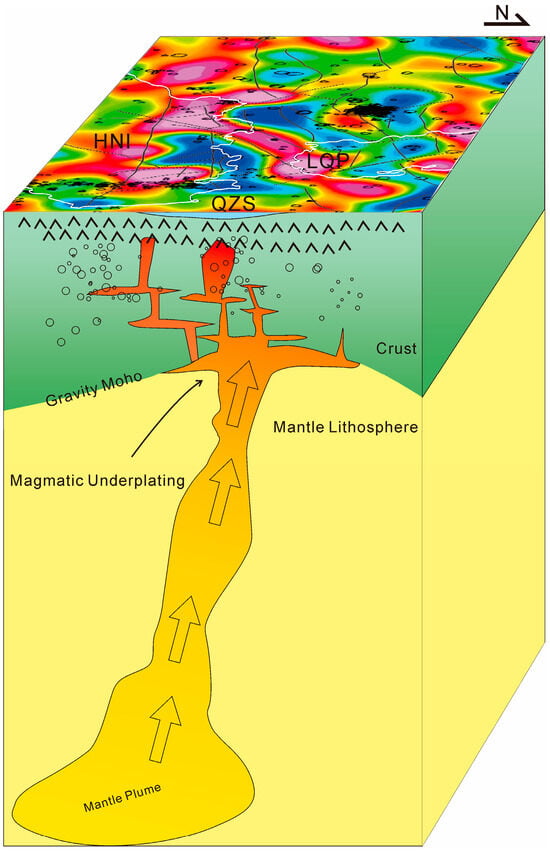
Figure 8.
Schematic plot of seismogenic tectonic environment model of northern Hainan Island modified from [20,59,60]. The black circles denote earthquakes, and the gravity Moho depth derives from Figure 7. The surface is part of D5 covered with faults and the earthquake epicenter. HNI, Hainan Island; QZS, Qiongzhou Strait; LQP, Leiqiong Peninsula. The white line represents the coastline.
6. Conclusions
In this study, we investigated the crustal structure of Hainan Island and surrounding seabed using newly acquired airborne gravity data. Multiscale wavelet analysis, the Parker–Oldenburg inversion method, and the radial averaged logarithmic power spectra analysis method were used to extract gravity anomaly information for crustal deformation and density structure. Through combining the decomposed result with seismic data, the relationship between the crustal structural architecture and seismicity patterns is also discussed. The key findings are summarized as follows:
- The results of the wavelet-based multiscale analysis reveal the crustal structure at depth. The results show that there are NE-trending banded anomalies in the middle and lower crust, interpreted as remnants of the subduction of the Mesozoic paleo-Pacific plate subduction. These findings provide critical evidence for Hainan Island’s tectonic evolution within the Paleo-Pacific tectonic domain system during the Mesozoic era.
- The Moho depth is obtained by gravity data inversion. The average depth of the Moho surface in the study area is about 24.94 km, and the Moho surface fluctuates greatly in the range of 16.2–31.4 km. There are two significant Moho depression areas and three local uplift zones of the Moho surface, among which the Qiongbei Moho uplift exhibits a direct spatial correlation with the Hainan mantle plume. This specific uplift is interpreted as a surface manifestation of the upper mantle material ascent driven by plume-related thermochemical processes.
- The results of the decomposed gravity anomalies and natural earthquake distribution reveal that the regional seismic activity is primarily controlled by the left-lateral strike-slip motion of the YGHF and thermomechanical processes associated with the Hainan Plume. Most of the seismic activities in the north and southeast of Hainan Island may be related to the deep-sourced mantle upwelling of the Hainan Plume along the Mesozoic fault gap.
We conclude that the airborne gravity survey is an important remote sensing method to provide a new view of revealing the deep crustal structure across both offshore and onshore regions.
Author Contributions
Conceptualization, X.L., X.Z., W.Z. and H.W.; data curation, X.L. and R.W.; formal analysis, X.L. and X.Z.; funding acquisition, X.Z. and H.W.; investigation, X.L.; methodology, X.L., X.Z., W.Z. and Y.S.; supervision, H.W.; visualization, X.L. and R.W.; writing—original draft, X.L.; writing—review and editing, X.L. and G.Y. All authors have read and agreed to the published version of the manuscript.
Funding
This work was supported by the Programs of China Geological Survey (Grant No. DD20243057; DD20221715; DD20240090; DD20243216) and the National Natural Science Foundation of China (Grant No. U2344203).
Institutional Review Board Statement
Not applicable.
Informed Consent Statement
Not applicable.
Data Availability Statement
The original contributions presented in this study are included in the article. Further inquiries can be directed to the corresponding authors.
Acknowledgments
We are grateful to the editors and anonymous reviewers for their constructive comments on the manuscript.
Conflicts of Interest
The authors declare no conflicts of interest.
References
- Bird, P. An updated digital model of plate boundaries. Geochem. Geophys. Geosyst. 2003, 4, 1027. [Google Scholar] [CrossRef]
- Metcalfe, I. Gondwana dispersion and Asian accretion: Tectonic and palaeogeographic evolution of eastern Tethys. J. Asian Earth Sci. 2013, 66, 1–33. [Google Scholar] [CrossRef]
- Cawood, P.A.; Zhao, G.; Yao, J.; Wang, W.; Xu, Y.; Wang, Y. Reconstructing South China in Phanerozoic and Precambrian supercontinents. Earth-Sci. Rev. 2017, 186, 173–194. [Google Scholar] [CrossRef]
- Xia, B.D.; Yu, J.H.; Fang, Z.; Wand, C.; Cui, X. Geochemical Characteristics and Origin of the Hercynian–Indosinian Granites of Hainan Island, China. Geochimica 1990, 4, 365–373, (In Chinese with English Abstract). [Google Scholar]
- Dilek, Y.; Tang, L. Magmatic record of the Mesozoic geology of Hainan Island and its implications for the Mesozoic tectonomagmatic evolution of SE China: Effects of slab geometry and dynamics in continental tectonics. Geol. Mag. 2021, 158, 118–142. [Google Scholar] [CrossRef]
- Fang, N. A new model on the Mesozoic “South China Sea” (SCS): Reconstructing the Hainan marginal arc and recognizing the Tethyan SCS. Earth Sci. Front. 2016, 23, 107–119. [Google Scholar]
- Lebedev, S.; Nolet, G. Upper mantle beneath Southeast Asia from S velocity tomography. J. Geophys. Res. 2003, 108, 2048. [Google Scholar] [CrossRef]
- Montelli, R.; Nolet, G.; Dahlen, F.A.; Masters, G. A catalogue of deep mantle plumes: New results from finite-frequency tomography. Geochem. Geophys. Geosyst. 2006, 7, 1–69. [Google Scholar] [CrossRef]
- Lei, J.; Zhao, D.; Steinberger, B.; Wu, B.; Shen, F.; Li, Z. New seismic constraints on the upper mantle structure of the Hainan plume. Phys. Earth Planet. Inter. 2009, 173, 33–50. [Google Scholar] [CrossRef]
- Xia, S.; Zhao, D.; Sun, J.; Huang, H. Teleseismic imaging of the mantle beneath southernmost China: New insights into the Hainan plume. Gondwana Res. 2016, 36, 46–56. [Google Scholar] [CrossRef]
- Lu, H.; Lei, J.; Zhao, D.; Xu, Y.G.; Sun, C.; Hu, X. Pn anisotropic tomography of Hainan Island and surrounding seabeds: New insights into the Hainan mantle plume. J. Geophys. Res. Solid Earth 2022, 127, e2021JB023609. [Google Scholar] [CrossRef]
- Wang, P.; Li, Q.; Li, C.F. Geology of the China Seas; Elsevier: Amsterdam, The Netherlands, 2014. [Google Scholar]
- Sun, W.; Lin, C.; Zhang, L.; Liao, R.; Li, C. The formation of the South China Sea resulted from the closure of the Neo-Tethys: A perspective from regional geology. Acta Petrol. Sin. 2018, 34, 3467–3478. [Google Scholar]
- Lin, J.; Li, J.; Xu, Y.; Sun, Z.; Xia, S.; Huang, X.; Xie, X. Ocean drilling and major advances in marine geological and geophysical research of the South China Sea. Haiyang Xuebao 2019, 41, 125–140. [Google Scholar] [CrossRef]
- Chen, E.; Huang, Y. Preliminary discussion on the 1605 Qiong Zhou earthquake and its Seismogenetic Structure. Seismol. Geol. 1979, 1, 37–44, (In Chinese with English Abstract). [Google Scholar]
- Wei, S.S.; Chen, Y.J. Seismic evidence of the Hainan mantle plume by receiver function analysis in southern China. Geophys. Res. Lett. 2016, 43, 8978–8985. [Google Scholar] [CrossRef]
- Huang, H.; Tosi, N.; Chang, S.J.; Xia, S.; Qiu, X. Receiver function imaging of the mantle transition zone beneath the South China block. Geochem. Geophys. Geosyst. 2016, 16, 3666–3678. [Google Scholar] [CrossRef]
- Jia, S.X.; Li, Z.; Xu, C.; Shen, F.; Zhao, W.; Yang, Z.; Yang, J.; Lei, Y. Crustal structure features of the Leiqiong depression in Hainan Province. Chin. J. Geophys. 2006, 49, 1385–1394. (In Chinese) [Google Scholar]
- Xia, S.; Fan, C.; Wang, D.; Cao, J.; Zhao, F. Hyperextended crustal structure of the Qiongdongnan Basin and subsequent magmatic influence from the Hainan mantle plume. Sci. China Earth Sci. 2022, 65, 845–862. [Google Scholar] [CrossRef]
- Li, Z.X.; Lei, J.S.; Zhao, D.; Bateer, W.; Fanluan, S.; Qiu, X. 3D P-wave velocity structure of the crust beneath Hainan Island and adjacent regions. Acta Seismol. Sin. 2008, 30, 441–448. [Google Scholar] [CrossRef]
- Liu, H.; Chen, F.; Leng, W.; Zhang, H.; Xu, Y. Crustal Footprint of the Hainan Plume Beneath Southeast China. J. Geophys. Res. Solid Earth 2017, 123, 3065–3079. [Google Scholar] [CrossRef]
- Liu, Y.; Hu, D.; Xu, Y.; Chen, C. 3d magnetotelluric imaging of the middle-upper crustal conduit system beneath the lei-hu-ling volcanic area of northern Hainan island, China. J. Volcanol. Geotherm. Res. 2019, 371, 220–228. [Google Scholar] [CrossRef]
- Lin, J.N.; Xia, S.; Wang, X.; Wang, D. Seismogenic crustal structure affected by the Hainan mantle plume. Gondwana Res. 2022, 103, 23–36. [Google Scholar] [CrossRef]
- Huang, H.; Qiu, X.; Xia, S. Crustal structure and Poisson’s ratio beneath Hainan Island. J. Trop. Oceanogr. 2012, 31, 65–70. [Google Scholar]
- Hu, Y.; Hao, M.; Qin, S.; Ji, L.; Song, S. Present-day 3D crustal motion and fault activity in the Hainan island. Chin. J. Geophys. 2018, 61, 2310–2321. (In Chinese) [Google Scholar] [CrossRef]
- Wu, S.; Lu, X.; Li, G.; Long, G. Tectonics and discrepant evolution of Cenozoic sedimentary basins adjacent Hainan Island. Acta Geol. Sin. 2024, 98, 16–30. [Google Scholar]
- Li, Z.X.; Li, X.H.; Zhou, H.; Kinny, P.D. Grenvillian continental collision in south China: New shrimp u-pb zircon results and implications for the configuration of Rodinia. Geology 2002, 30, 163–166. [Google Scholar] [CrossRef]
- Li, Z.X.; Bogdanova, S.V.; Collins, A.S.; Davidson, A.; Waele, B.D.; Ernst, R.E.; Fitzsimos, I.C.W.; Fuck, R.A.; Gladkochub, D.P.; Jacobs, J.; et al. Assembly, configuration, and break-up history of Rodinia: A synthesis. Precambr. Res. 2008, 160, 179–210. [Google Scholar] [CrossRef]
- Xu, D.; Kusiak, M.A.; Wang, Z.; Chen, H.; Bakun-Czubarow, N.; Wu, C.; Konečný, P.; Hollings, P. Microstructural observation and chemical dating on monazite from the Shilu group, Hainan province of south China: Implications for origin and evolution of the Shilu Fe–Co–Cu ore district. Lithos 2015, 216–217, 158–177. [Google Scholar] [CrossRef]
- Wang, Z.; Xu, D.; Hu, G.; Yu, L.; Wu, C.; Zhang, Z.; Cai, J.; Shan, Q.; Hou, M.; Chen, H. Detrital zircon u-pb ages of the proterozoic metaclastic-sedimentary rocks in Hainan province of south China: New constraints on the depositional time, source area, and tectonic setting of the Shilu Fe-Co-Cu ore district. J. Asian Earth Sci. 2015, 113, 1143–1161. [Google Scholar] [CrossRef]
- Jiang, X.Y.; Li, X.H. In situ zircon u-pb and hf-o isotopic results for ca. 73 ma granite in Hainan island: Implications for the termination of an andean-type active continental margin in southeast China. J. Asian Earth Sci. 2014, 82, 32–46. [Google Scholar] [CrossRef]
- Tang, L.; Chen, H.; Dong, C.; Yang, S.; Shen, Z.; Cheng, X.; Fu, L. Middle triassic post-orogenic extension on Hainan island: Chronology and geochemistry constraints of bimodal intrusive rocks. Sci. China Earth Sci. 2013, 56, 783–793. [Google Scholar] [CrossRef]
- Zou, H.; Fan, Q. U–th isotopes in hainan basalts: Implications for sub-asthenospheric origin of em2 mantle endmember and the dynamics of melting beneath Hainan island. Lithos 2010, 116, 145–152. [Google Scholar] [CrossRef]
- Fan, Q.; Sun, Q.; Li, N.; Sui, J. Periods of volcanic activity and magma evolution of Holocene in North Hainan Island. Acta Petrol. Sin. 2004, 20, 533–544. [Google Scholar]
- Sun, X.; Zhang, X.; Zhang, G.; Lu, B.; Yue, J.; Zhang, B. Texture and tectonic attribute of Cenozoic basin basement in the northern South China Sea. Sci. China Earth Sci. 2014, 57, 1199–1211. [Google Scholar] [CrossRef]
- Zhu, M.; Graham, S.; McHargue, T. The red river fault zone in the Yinggehai Basin, South China Sea. Tectonophysics 2009, 476, 397–417. [Google Scholar] [CrossRef]
- Yang, G.; Yin, H.; Jia, D.; Wang, H.; Wang, W.; Xu, W. New insights into the structure of the Yinggehai Basin and its tectonic implications, South China Sea: Evidence from scaled physical models. Basin Res. 2024, 36, e12888. [Google Scholar] [CrossRef]
- Xia, S.; Lin, J.; Cao, J. Seismicity and Seismogenic Structure in the Northern Coastal Area of the South China Sea. Geotecton. Metallog. 2022, 46, 455–470. [Google Scholar] [CrossRef]
- Xiong, S. Innovation and application of airborne geophysical exploration technology. J. Geomech. 2020, 26, 791–818. [Google Scholar] [CrossRef]
- Tong, J.; Zhang, X.; Zhang, W.; Xiong, S. Marine strata morphology of the south yellow sea based on high-resolution aeromagnetic and airborne gravity data. Mar. Pet. Geol. 2018, 96, 429–440. [Google Scholar] [CrossRef]
- Yang, W.; Shi, Z.; Hou, Z.; Cheng, Z. Discrete Wavelet Transform for Multiple Decomposition of Gravity Anomalies. Chin. J. Geophys. 2001, 44, 534–541. (In Chinese) [Google Scholar]
- Yang, W.-C.; Hou, Z.-Z.; Yu, C.-Q. 3D crustal density structure of West Yunnan and its tectonic implications. Chin. J. Geophys. 2015, 58, 3902–3916. (In Chinese) [Google Scholar] [CrossRef]
- Yang, W.C.; Sun, Y.Y.; Hou, Z.Z.; Yang, C.Q. A multi-scale scratch analysis method for quantitative interpretation of regional gravity fields. Chin. J. Geophys. 2015, 58, 41–53. [Google Scholar]
- Xu, C.; Liu, Z.; Luo, Z.; Wu, Y.; Wang, H. Moho topography of the Tibetan plateau using multi-scale gravity analysis and its tectonic implications. J. Asian Earth Sci. 2017, 138, 378–386. [Google Scholar] [CrossRef]
- Wang, X.; Jiang, W.; Zhang, J.; Shen, W.; Fu, Z. Gravity anomaly and fine crustal structure in the middle segment of the Tan-Lu fault, eastern Chinese mainland. Asian Earth Sci. 2022, 224, 105027. [Google Scholar] [CrossRef]
- Bhimasankaram, V.L.S.; Nagendra, R.; Rao, S.V.S. Interpretation of gravity anomalies due to finite inclined dikes using fourier transformation. Geophysics 1977, 42, 51–59. [Google Scholar] [CrossRef]
- Hou, Z.; Yang, W. Wavelet Transform and Multi-Scale Analysis on Gravity Anomalies of China. Chin. J. Geophys. 1997, 40, 85–95. (In Chinese) [Google Scholar]
- Parker, R.L. The rapid calculation of potential anomalies. Geophys. J. R. Astron. Soc. 1973, 31, 447–455. [Google Scholar] [CrossRef]
- Oldenburg, D.W. The inversion and interpretation of gravity anomalies. Geophysics 1974, 39, 526–536. [Google Scholar] [CrossRef]
- Zhu, J.; Xu, H.; Qiu, X.; Ye, C.; Li, S. Crustal structure and rifting of the northern South China Sea margin: Evidence from shoreline-crossing seismic investigations. Geol. J. 2017, 53, 2065–2083. [Google Scholar] [CrossRef]
- Hou, Z.; Yang, W.; Liu, J. Multiscale Inversion of the Density Contrast Within the Crust of China. Chin. J. Geophys. 1998, 41, 642–651. (In Chinese) [Google Scholar]
- Li, F.; Sun, Z.; Yang, H. Possible spatial distribution of the Mesozoic volcanic arc in the present-day South China Sea continental margin and its tectonic implications. J. Geophys. Res. Solid Earth 2018, 123, 6215–6235. [Google Scholar] [CrossRef]
- Xu, C.; Zhang, L.; Shi, H.; Brix, M.R.; Huhma, H.; Chen, L.; Zhang, M.; Zhou, Z. Tracing an Early Jurassic magmatic arc from South to East China Seas. Tectonics 2017, 36, 466–492. [Google Scholar] [CrossRef]
- Zhao, Z.; Sun, Z.; Wang, Z.; Sun, Z. The mechanics of continental extension in Qiongdongnan basin, northern south China sea. Mar. Geophys. Res. 2015, 36, 197–210. [Google Scholar] [CrossRef]
- Xie, C.F.; Zhu, J.C.; Ding, S.J.; Zhang, Y.M.; Li, Z.H. Age and petrogenesis of the jianfengling granite and its relationship to metallogenesis of the Baolun gold deposit, Hainan island. Acta Petrol. Sin. 2006, 22, 2493–2508. [Google Scholar]
- Yan, Q.; Metcalfe, I.; Shi, X. U-pb isotope geochronology and geochemistry of granites from Hainan island (northern south China sea margin): Constraints on late paleozoic-mesozoic tectonic evolution. Gondwana Res. 2017, 49, 333–349. [Google Scholar] [CrossRef]
- Wei, F.; Wei, W.; Yu, H. The Cenozoic volcanic fields in northern Hainan Island and Leizhou Peninsula, South China: Eruption history, magma source and dynamic background. Geol. Soc. Lond. Spec. Publ. 2020, 510, 179–196. [Google Scholar] [CrossRef]
- Robert, H.; Spakman, W. Subducted slabs beneath the eastern Indonesia–Tonga region: Insights from tomography. Earth Planet. Sci. Lett. 2002, 201, 321–336. [Google Scholar]
- Pan, M.; Yang, T.; Le, B.M.; Dai, Y.; Xiao, H. The Magmatic Patterns Formed by the Interaction of the Hainan Mantle Plume and Lei–Qiong Crust Revealed through Seismic Ambient Noise Imaging. Geosciences 2024, 14, 63. [Google Scholar] [CrossRef]
- Yang, X.; Shen, C.Y.; Zhu, Y.Q.; Yang, G.; Sun, K.; Tan, H. Study on gravity invertion of three-dimensional density structure of the crust in Tangshan Ms7.8 earthquake area. Chinese J. Geophys. 2023, 66, 183–196. (In Chinese) [Google Scholar] [CrossRef]
Disclaimer/Publisher’s Note: The statements, opinions and data contained in all publications are solely those of the individual author(s) and contributor(s) and not of MDPI and/or the editor(s). MDPI and/or the editor(s) disclaim responsibility for any injury to people or property resulting from any ideas, methods, instructions or products referred to in the content. |
© 2025 by the authors. Licensee MDPI, Basel, Switzerland. This article is an open access article distributed under the terms and conditions of the Creative Commons Attribution (CC BY) license (https://creativecommons.org/licenses/by/4.0/).